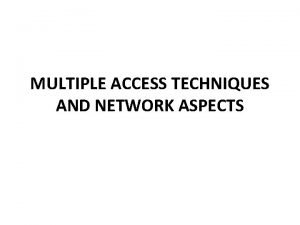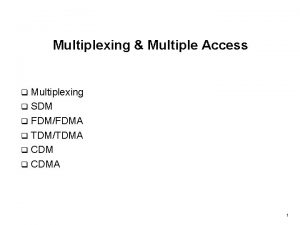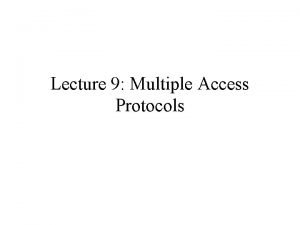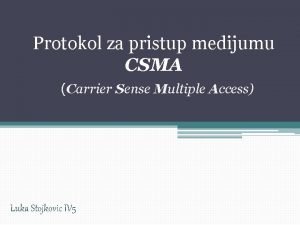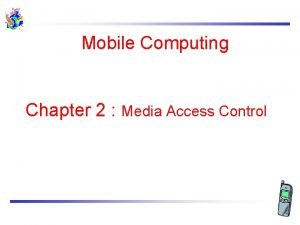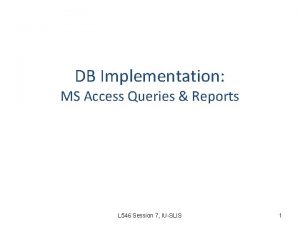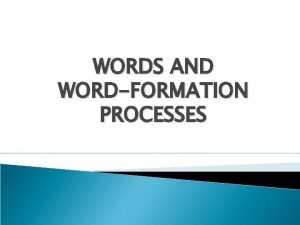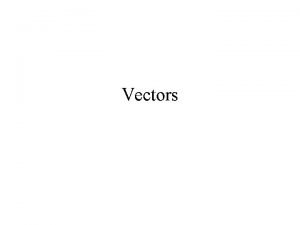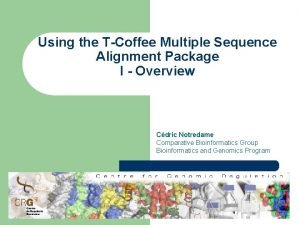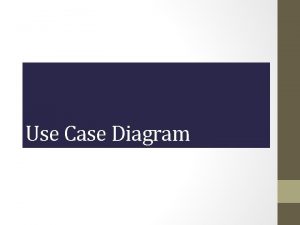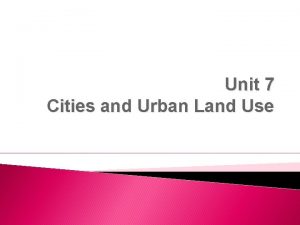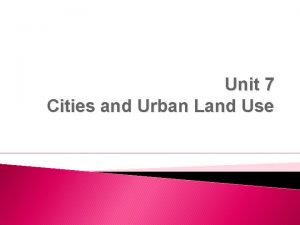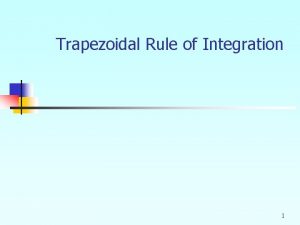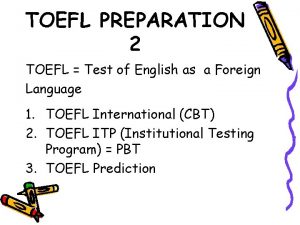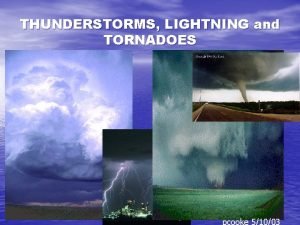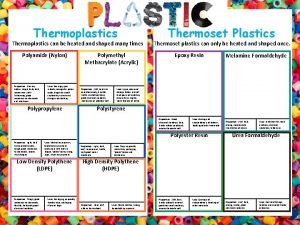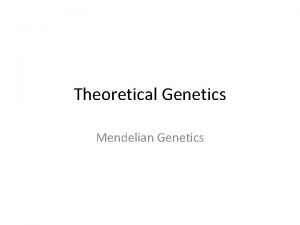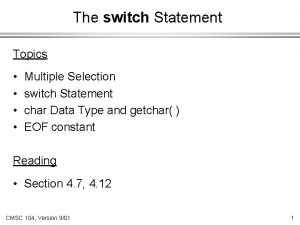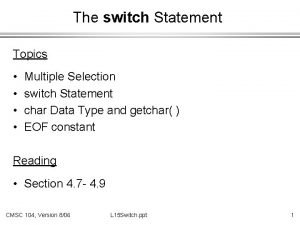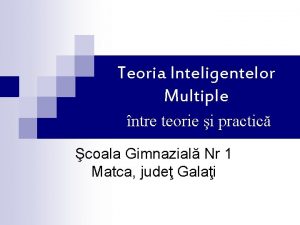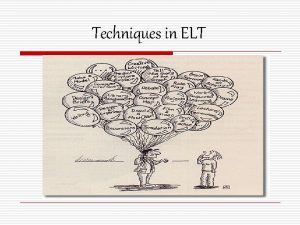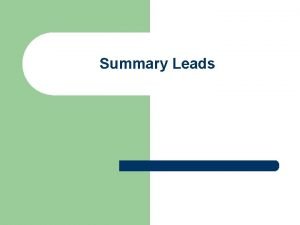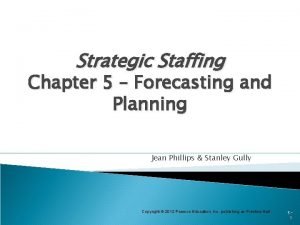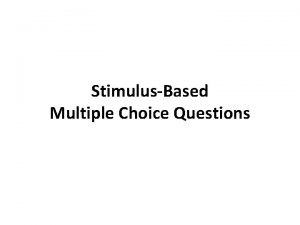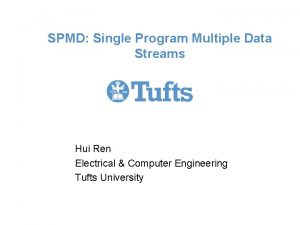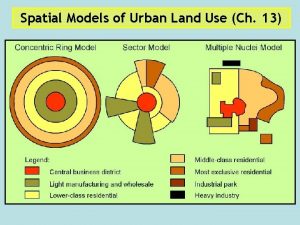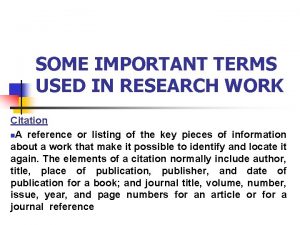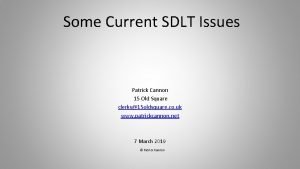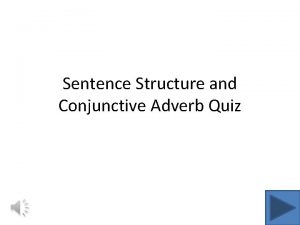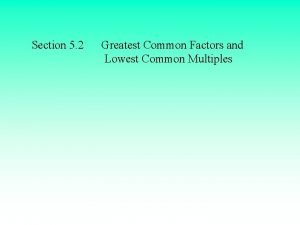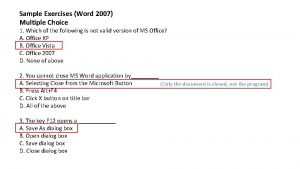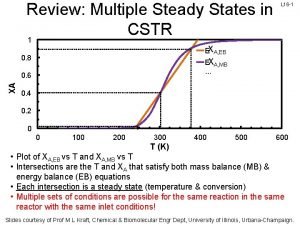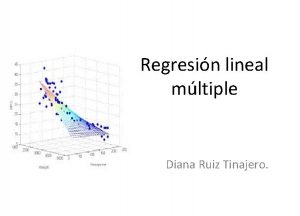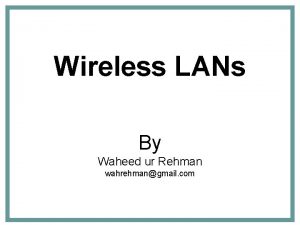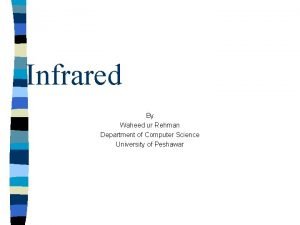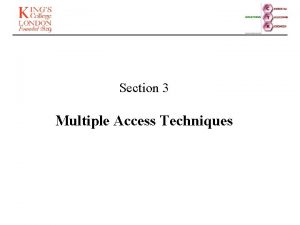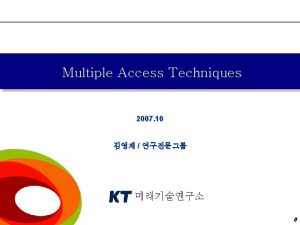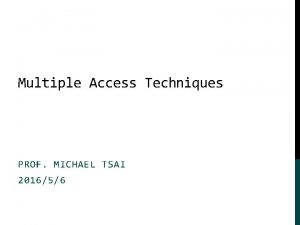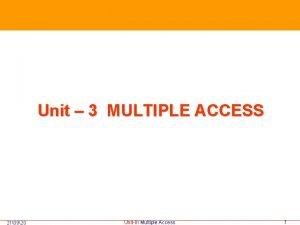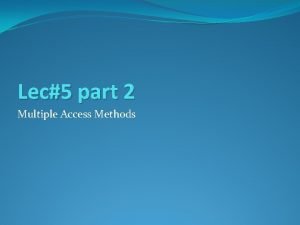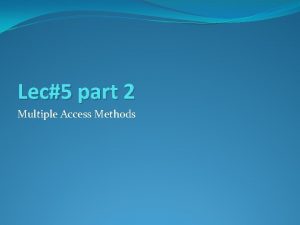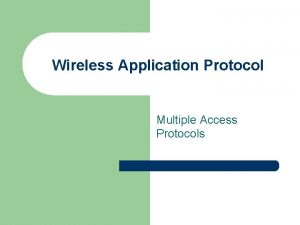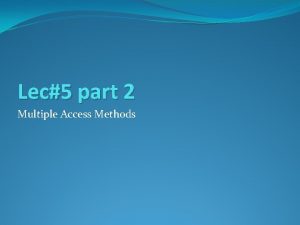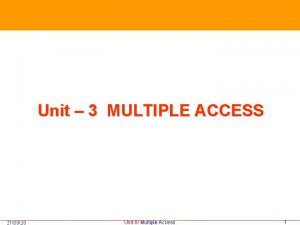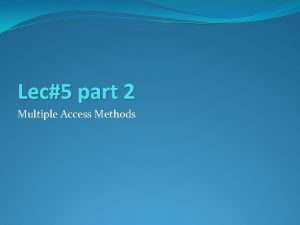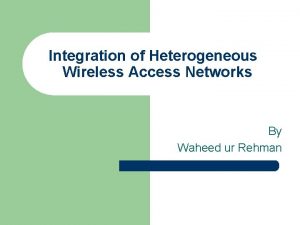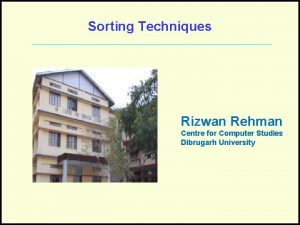Multiple Access Techniques Waheed ur Rehman wahrehmangmail com




































































![Bit 0 bit 0 -1 c 1 [+1+1] c 2 1 -1 [+1 -1] Bit 0 bit 0 -1 c 1 [+1+1] c 2 1 -1 [+1 -1]](https://slidetodoc.com/presentation_image_h2/74b79f8e9ba51161ee3535046b9971b6/image-69.jpg)

- Slides: 70

Multiple Access Techniques Waheed ur Rehman wahrehman@gmail. com

Multiple Access Random Access Aloha CSMA/CD Controlled Access CSMA/CA Reservation Polling Channelization Token passing FDMA CDMA TDMA

Random Access • • • No station is superior to another None is assigned control over other No schedule time for a station to transmit Transmission is random among the station Collision may occur in case if two stations tries to transmit at the same time

Random Access Aloha: • Earliest random access method • Developed at university of hawaii in 1970 • Designed for wireless LANs • But can be used by any shared medium • Pure and slotted aloha

Random Access Pure Aloha: • The original aloha protocol is called pure aloha • Any station can transmit when they have something to send • Requires an ACK • A frame needs to be retransmitted in case of no ACK • In case of collision, each station has to wait for random amount of time before retransmission.

Random Access Pure Aloha vulnerable time

Random Access Slotted aloha: • Fixed size transmission slots • A station only transmit at the beginning of the slot • Collision can occur if two station tries to send in same time slot • In case of collision stations has to wait for a random amount of time • Random time is calculated using backoff algorithm

Random Access Slotted aloha:

Random Access Backoff Algorithm: • In case of collision an algorithm is devised for retransmission • In case of collision random number N is selected between 0. . [2 K-1], where k is the number of collision • That random number N is then multiplied with maximum propagation delay Tp • Time to wait = N * Tp • If k=1 then N =0, 1 • If k=2 then N = 0, 1, 2, 3

Binary Exponential Backoff (cont’d) slot length = 2 x end-to-end delay = 50 ms A t=0 ms: t=100 ms: t=150 ms: t=250 ms: B Assume A and B collide (k. A = k. B = 1) A, B choose randomly from 21 slots: [0, 1] Assume A chooses 1, B chooses 1 A and B collide (k. A = k. B = 2) A, B choose randomly from 22 slots: [0, 3] Assume A chooses 2, B chooses 0 B transmits successfully A transmits successfully

Random Access • Maximum number of collisions allowed are 16 • After collision number 10 the random number selected between 0. . 1023 • After 16 collision the transmission is aborted and can be retransmitted some other time • The typical time for Tp can be around 51. 2 microseconds

Random Access CSMA: • Carrier sense multiple access • Listen to the medium first • Sense before transmit • Listen before talk • Reduce collisions but cannot eliminate it • Can be persistent and non persistent

The Effect of Propagation Delay on CSMA packet A B carrier sense = idle Transmit a packet Collision

Propagation Delay and CSMA • Contention (vulnerable) period in Pure ALOHA – two packet transmission times • Contention period in Slotted ALOHA – one packet transmission time • Contention period in CSMA – up to 2 x end-to-end propagation delay Performance of CSMA > Performance of Slotted ALOHA > Performance of Pure ALOHA

Random Access CSMA: • There are several types of CSMA protocols: – 1 -Persistent CSMA – Non-Persistent CSMA – P-Persistent CSMA

Random Access 1 -Persistent : 1. If the medium is idle, transmit otherwise goto 2 2. if the medium is busy continue to listen until channel is sensed idle, then transmit immediately. - Highest chance of collision because two stations might find the medium idle and might transmit simultaneously The protocol is called 1 -persistent because the host transmits with a probability of 1 whenever it finds the channel idle.

Random Access Non persistent CSMA 1. If the medium is idle, transmit otherwise goto 2 2. If the medium is busy, wait for random amount of time and repeat step 1 - Problem , capacity is wasted since medium is idle following the end of transmission

Tradeoff between 1 - and Non. Persistent CSMA • If B and C become ready in the middle of A’s transmission, – 1 -Persistent: • B and C collide – Non-Persistent: • B and C probably do not collide • If only B becomes ready in the middle of A’s transmission, – 1 -Persistent: • B succeeds as soon as A ends – Non-Persistent: • B may have to wait

Random Access P-Persistent CSMA • Optimal strategy: use P-Persistent CSMA • Assume channels are slotted • One slot = contention period (i. e. , one round trip propagation delay)

Random Access P-Persistent CSMA (cont’d) 1. Sense the channel – If channel is idle, transmit a packet with probability p • if a packet was transmitted, go to step 2 • if a packet was not transmitted, wait one slot and go to step 1 – If channel is busy, wait one slot and go to step 1. 2. Detect collisions – If a collision occurs, wait a random amount of time and go to step 1

P-Persistent CSMA (cont’d) • Consider p-persistent CSMA with p=0. 5 – When a host senses an idle channel, it will only send a packet with 50% probability – If it does not send, it tries again in the next slot.

Comparison of CSMA and ALOHA Protocols (Number of Channel Contenders)

CSMA/CD • In CSMA protocols – If two stations begin transmitting at the same time, each will transmit its complete packet, thus wasting the channel for an entire packet time • In CSMA/CD protocols – The transmission is terminated immediately upon the detection of a collision – CD = Collision Detect

Random Access CSMA/CD • Carrier sense multiple access with collision detection • Station monitors the medium after it sends the frame • If successful then station’s job done • Retransmit the frame otherwise (collision) • Transmission and sensing of the medium simultaneously • In case of collision a jam signal is sent to notify all the station about the collision

Random Access CSMA/CD • Carrier sense multiple access with collision detection 1. If the medium is idle, transmit otherwise goto 2 2. If the medium is busy, transmit using persistent tech. 3. If a collision occurs during transmission a. transmit a jam signal b. wait for random time and re-attempt(16 times) c. random time generated according to exponential backoff algorithm

CSMA/CD collision detection

CSMA/CD (cont’d) • Carrier sense – reduces the number of collisions • Collision detection – reduces the effect of collisions, making the channel ready to use sooner

Collision detection time How long does it take to realize there has been a collision? Worst case: 2 x end-to-end prop. delay packet A B




Random Access CSMA/CD Minimum Frame Size: • Minimum frame restriction apply • Before sending last bit of the frame, sending station must detect a collision(if. Any) • Once the frame is sent, sending station doesn’t keep the copy • Tfr = 2 Tp


Random Access Difference between aloha and CSMA/CD • In addition to the persistent process the medium needs to be sensed first • In aloha first the frame is transmitted and then wait for ACK. In CSMA/CD station receives and transmit continuously (on two different ports) • Sending of the jam signal that enforce the collision in case other stations have not yet sensed the collision.

Random Access Question: How can the station detect the medium?

Random Access Energy Levels: • Three values • 0, normal and abnormal • 0 means line is idle • Normal means successful capture of the channel for transmission • Abnormal means that collision occurs

Random Access CSMA/CA • Carrier sense multiple access with collision avoidance • Three strategies Interframe Space (IFS) • Sense the channel, if it is idle don’t transmit wait for period of time called interframe space • If the medium is idle even after IFS, still needs to wait for time equal to contention window • IFS can also be used to define the priority of a station or a frame • For example, a station that is assigned a shorter IFS has a higher priority

Random Access Contention Window: • Amount of time divided into slots • A station that is ready to send choose a random number of slot as its wait time • The time slot in the window changes according to the backoff algorithm • Station needs to sense after each time slot • If station finds the channel idle then continue, if busy, then halt and continue when idle • Station needs to sense the channel after each time slot • If the station finds the channel busy, it doesn’t restart the process ; it just stops the timer and restart it when the channel is sensed as idle. ACK: • ACK is needed for ensuring the successful delivery of the transmission

Controlled Access Reservation: • a station needs to make a reservation before sending data • Time is divided into intervals • In each interval a reservation frame is proceeds the data frames sent in that interval • If there are N stations in the system there are exactly N reservation minislots in the reservation frame. • Each mini slot belongs to a station • When a station needs to send data it makes reservation into its own mini slot • The station that have made reservation can send their data frames after the reservation frames

Controlled Access 1 2 3 4 5 0 0 0 1 2 3 4 5 Data Station 1 1 0 0 1 2 3 4 5 Data station 4 station 3 station 1 Reservation Frame Reservation Access Method • In first interval station 1, 3 and 4 have made reservations • In second interval only station 1 has made reservation 1 0 1 1 0


Controlled Access Polling: • One station must be primary • All the other are secondary • Primary control the secondary stations • All transmission is through primary station • There are two function Select and Poll

Controlled Access Select: • Used when primary device has something to send • Primary station send select frame to alert the secondary receiver of incoming transmission • After select , , wait for ACK • After ACK sends data • Wait for ACK again to ensure successful delivery


Controlled Access Poll: • Used when secondary station needs to send • Primary station send poll to ask if there is anything to send • Secondary stations might reply with either NAK or with data frames • If NAK the primary station sends poll to the next station • If data frame then primary ACK the receipt


Controlled Access Token Passing • Each station has a predecessor and successor • Token gives right to a station to send data • When a station has something to send it waits until it gets the token • When the station has no data to send it release the token • Token management is required for 1. amount of time a station can hold token 2. monitoring to ensure the token is not destroyed

Priority Transmission: Example A B C D Host B has 1 frame of priority 3 to send to A Host C has 1 frame of priority 2 to send to A Host D has 1 frame of priority 4 to send to A Token starts at host A with priority 0 and circulates clockwise Host C is the monitor station

Example (cont’d) Event Token/Frame AC Field A generates a token P=0, M=0, T=0, R=0 B grabs the token and sets the message destination to A P=3, M=0, T=1, R=0 Frame arrives at C, and C reserves priority level 2. Monitor bit set. P=3, M=1, T=1, R=2 Frame arrives at D, and D attempts to reserve priority level 4: P=3, M=1, T=1, R=4 Frame arrives at A, and A copies it P=3, M=1, T=1, R=4 Frame returns to B, so B removes it, and generates a new token P=4, M=0, T=0, R=0 Token arrives at C, but its priority is too high. C reserves priority 2. M bit. P=4, M=1, T=0, R=2

Example (cont’d) Event Token/Frame AC Field Token arrives at D, and D grabs it, sending a message to A P=4, M=0, T=1, R=2 Frame arrives at A, and A copies it P=4, M=0, T=1, R=2 Frame arrives at B, which does nothing to it P=4, M=0, T=1, R=2 Frame arrives at C, which sets the monitor bit P=4, M=1, T=1, R=2 Frame returns to D, so D removes it and generates a new token with P=2, M=0, T=0, R=0 etc… Attempt to complete this scenario on your own.



Channelization • Available bandwidth of a link is shared in time, frequency or through code between different stations • FDMA, TDMA, CDMA FDMA • Available bandwidth is divided into frequency bands • Each station is assigned a band to send data • i. e. each band is reserved for a specific station and is there all the time • To prevent interference the allocated bands are separated by guard bands


Channelization FDMA • FDMA is usually used when fairly large bandwidth is available like radio, coax or fiber optic • Use of guard bands means that in practice whole range of frequency band cannot be used • Guard band reduces the efficiency of the system • Number of bands increase results in width of each band reduced • Its also proportional to number of guard band intervals • FDMA is conceptually simple system

Channelization Problems with FDMA • Each link takes up one frequency band require one transmitter and receiver. • For full duplex link, we need to have active transmitter and receiver, which makes circuitry more complex • If variable data rate transmission is desirable then two methods, – Either widen each frequency band • Result in wastage of resource for those who don’t need fast links – Combine several bands • Increase complexity • FDMA is ideal where data rate is constant like in voice and analog TV signals.

Channelization TDMA • Stations share bandwidth of a channel in time • Each station is allocated a time slot during which it can send data • Each station transmit its data in its assigned time slot • The main problem can be synchronization • Each station must follow the beginning of its time slot and its location • This is difficult because of propagation delay among distant stations • To overcome guard time are introduced


Channelization TDMA • If a signal is transmitted @ 1000 bits per second, means 1 bit after each millisecond arrives • If we transmit as a burst, there will be no need to transmit a bit after every millisecond • E. g. 10 bit burst could be sent after each 10 millisecond • In this case we need to pause the transmission for some time and transmit after specified time, in the form of bursts

Channelization Combining TDMA and FDMA • It means that the bandwidth is divided frequency wise and every band is further divided time wise (GSM and D-AMPS systems etc) • Used in radio communication • Used to achieve higher data rate • To achieve higher data rate only by using TDMA will result in very complex circuitry, which contribute towards cost ultimately

Channelization CDMA • Code Division Multiple Access • It is different from FDMA because only one channel occupies the entire bandwidth of the link • It is different than TDMA because all stations can send data simultaneously • In CDMA, one channel carries all transmission simultaneously

Channelization An analogy • CDMA simply means communicating with different codes • For example in a big room people are sitting. • In TDMA every body has to speak but on their own turn • In FDMA we can think of them speaking to each others in some small separations • In CDMA they all can speak to each other simultaneously but in different language (code) • E. g. two people talk in French and reject everything else as noise if its not in French

Channelization • Lets assume we have four stations 1, 2, 3 and 4 connected to the same channel • Data from station 1 is d 1 and so on • The code assign to the station 1 is c 1 and so on • We assume that the assigned codes have two properties 1. if we multiply each code by another, we get 0 2. if we multiply each code by itself, we get 4 ( the number of stations) • With these properties in mind, all four stations wants to send data on a shared channel • Station 1 multiplies its data by its code to get d 1. c 1, station 2 gets d 2. c 2 and so on • The data that go on the channel is the sum of all these terms • d 1. c 1 + d 2. c 2 + d 3. c 3 + d 4. c 4

d 1 Channelization d 2 1 2 d 1. c 1 d 2. c 2 d 1. c 1+d 2. c 2+d 3. c 3+d 4. c 4 Data d 3. c 3 Common Channel d 4. c 4 3 4 d 3 d 4

Channelization • E. g. station 2 wants to extract information sent by station 1 • Station 2 multiplies c 1 by the data on the channel • Data = (d 1. c 1 + d 2. c 2 + d 3. c 3 + d 4. c 4). c 1 d 1. c 1 + d 2. c 1 + d 3. c 1 + d 4. c 1 4. d 1 as c 1. c 2=c 3. c 1=c 4. c 1=0 and c 1= 4 • Station divide it by 4 to get data.

Channelization Chips • CDMA is based on coding theory • Each station is assigned a code • That code is a sequence of numbers called chips • To code for previous example are • C 1 = +1 +1 C 2= +1 -1 C 3 = +1 +1 -1 -1 C 4= +1 -1 -1 +1 • The codes are not selected randomly they are selected carefully • The are called orthogonal sequences

Channelization Properties of orthogonal sequences 1. Each sequence is made of N elements, where N is the number of stations 2. If we multiply a sequence by a number, every element in the sequence is multiplied by that element. This is call multiplication of a sequence by a scalar. For example 2. [+1 +1 -1 -1] = [+2 +2 -2 -2] 3. If we multiply two equal sequences, elements by elements, and then add the results, we get N, where N is the number of elements in the each sequence. This is called the inner product of two equal sequence. For example [+1 +1 -1 -1] = 1+1+1+1 =4 4. If we multiply two different sequences, element by element, and add the results, we get 0. this is called inner product of two different sequence. For example [+1 +1 -1 -1]. [+1 +1] = 1+1 -1 -1 = 0 5. Adding two sequences means adding the corresponding elements. The result is another sequence. For example [+1 +1 -1 -1] + [+1 +1] = [+2 +2 0 0]

Channelization Data Representation • If a station needs to send 0 bit; it encodes it as -1 • If it is to send 1 bit; it encodes it as +1 • When a station is idle; it sends no signal, which is interpreted as 0 Data bit 0 -1 Data bit 1 +1 Silence 0
![Bit 0 bit 0 1 c 1 11 c 2 1 1 1 1 Bit 0 bit 0 -1 c 1 [+1+1] c 2 1 -1 [+1 -1]](https://slidetodoc.com/presentation_image_h2/74b79f8e9ba51161ee3535046b9971b6/image-69.jpg)
Bit 0 bit 0 -1 c 1 [+1+1] c 2 1 -1 [+1 -1] 2 [-1+1] d 2. c 2 [-1 -1] d 1. c 1 [-1 -1 -3 +1] Data [0 0 0 0] c 1 [+1+1 -1 -1] 3 Common Channel [+1 -1 -1+1] d 4. c 4 d 3. c 3 c 1 0 Silent [+1 -1 -1+1] 4 +1 Bit 1

Questions • What is difference of FDM and FDMA ? • What is difference of TDM and TDMA ?
 Dr waheed rehman
Dr waheed rehman Dậy thổi cơm mua thịt cá
Dậy thổi cơm mua thịt cá Cơm
Cơm The collaborator mirza waheed
The collaborator mirza waheed Dr khalid waheed
Dr khalid waheed Marcet boiler
Marcet boiler Different types of multiple access techniques
Different types of multiple access techniques Multiple access techniques in mobile computing
Multiple access techniques in mobile computing Fasih ur rehman
Fasih ur rehman Tahira rehman
Tahira rehman Abdur rahman chughtai
Abdur rahman chughtai Ben rehman
Ben rehman Multiple baseline vs multiple probe design
Multiple baseline vs multiple probe design Multiple instruction multiple data
Multiple instruction multiple data Difference between multiplexing and multiple access
Difference between multiplexing and multiple access Determine the taxonomy of multiple access protocols
Determine the taxonomy of multiple access protocols Cd protokol
Cd protokol Maca in mobile computing
Maca in mobile computing Access crosstab query multiple column headings
Access crosstab query multiple column headings Terminal access controller access-control system
Terminal access controller access-control system Terminal access controller access-control system
Terminal access controller access-control system Access control techniques
Access control techniques Fonction technique scooter
Fonction technique scooter How to write multiple choice questions
How to write multiple choice questions The word formation process
The word formation process In text citation
In text citation Multiple binary choice items
Multiple binary choice items Representing vectors
Representing vectors Tcoffee alignment
Tcoffee alignment Use case with multiple actors
Use case with multiple actors Include extend use case
Include extend use case Sub saharan african city model
Sub saharan african city model Multiple nuclei model definition geography
Multiple nuclei model definition geography Adverbial complement
Adverbial complement Urban realms model example
Urban realms model example Sprawl ap human geography
Sprawl ap human geography Trapezoidal formula
Trapezoidal formula Skill 15 listen for untrue conditions
Skill 15 listen for untrue conditions Stovepipe tornado
Stovepipe tornado Thermoplastics can be heated and shaped multiple times.
Thermoplastics can be heated and shaped multiple times. Sickle cell anemia genotype and phenotype
Sickle cell anemia genotype and phenotype Multiple selection statement
Multiple selection statement Multiple selection statement in c
Multiple selection statement in c Multiple incompatible antonyms examples
Multiple incompatible antonyms examples Multiple nuclei model
Multiple nuclei model O be thou damned inexecrable dog
O be thou damned inexecrable dog Multiple nuclei model
Multiple nuclei model In text citation chicago multiple authors
In text citation chicago multiple authors Nelu a spart o cana
Nelu a spart o cana Substitution drill examples
Substitution drill examples Identificar duplicados en r
Identificar duplicados en r Example of a summary lead
Example of a summary lead A transition analysis can account for multiple moves.
A transition analysis can account for multiple moves. She carried herself unwittingly like a goddess of victory
She carried herself unwittingly like a goddess of victory Stimulus based multiple choice questions
Stimulus based multiple choice questions Simple multiple linear regression
Simple multiple linear regression Sql
Sql What is spmd
What is spmd Multiple nuclei model
Multiple nuclei model Terms used in research
Terms used in research Sdlt multiple dwellings relief granny annex
Sdlt multiple dwellings relief granny annex Single user and multiple user operating system
Single user and multiple user operating system Smoldering lymphoma
Smoldering lymphoma Adverb quiz
Adverb quiz Greatest common factor of 60 and 75
Greatest common factor of 60 and 75 How to create multiple choice questions in word 2007
How to create multiple choice questions in word 2007 Multiple steady states in cstr
Multiple steady states in cstr Raisd aba
Raisd aba Multiple linear regression model
Multiple linear regression model Ejemplo de regresión lineal múltiple en la vida diaria
Ejemplo de regresión lineal múltiple en la vida diaria Recursion apcsa
Recursion apcsa






